Therapeutic Effects of Lithospermate B Complexed with Mg2+ or Zn2+ on Metabolic Syndrome Induced in Rats Fed with High-Fat Diet
Abstract
:1. Introduction
2. Results
2.1. Preparation and Identification of LSB Complexed with Mg2+ or Zn2+
2.2. Effects of MLB and ZLB on Appetite and Weight Gain of Rats
2.3. Effects of MLB and ZLB on Epididymal Fat and Liver Injury
2.4. Effects on Kidney Indices and Lipid Metabolism
2.5. Effects on Glucose Metabolism
2.6. Effects on Intracellular Signaling in Lipid and Glucose Metabolism
2.7. Effects on Proinflammatory and Oxidative Stress
2.8. Zinc Concentration
3. Discussion
4. Materials and Methods
4.1. Preparation of LSB Complexed with Mg2+ and Zn2+
4.2. HPLC/UV and LC−MSn Analyses of LSB, MLB, and ZLB
4.3. Animal and Drug Administration
4.4. Intraperitoneal Glucose Tolerance Test and Homeostatic Model Assessment Index
4.5. Liver Lipid Extraction and Measurement
4.6. Analysis of Blood Biochemistry
4.7. Histological Examination
4.8. Tissue Preparation and Western Blot Analysis
4.9. Thiobarbituric Acid Reactive Substances Assay
4.10. Zinc Concentraction Assay
4.11. Statistical Analysis
5. Conclusions
Author Contributions
Funding
Conflicts of Interest
References
- Grundy, S.M.; Brewer, H.B.J.; Cleeman, J.I.; Smith, S.C.J.; Lenfant, C. National Lung, Heart, and Blood Institute; Association American Heart. Definition of Metabolic Syndrome: Report of the National Heart, Lung, and Blood Institute/American Heart Association Conference on Scientific Issues Related to Definition. Arterioscl. Throm. Vas. 2004, 24, e13–e18. [Google Scholar]
- Moore, J.X.; Chaudhary, N.; Akinyemiju, T. Metabolic Syndrome Prevalence by Race/Ethnicity and Sex in the United States, National Health and Nutrition Examination Survey, 1988–2012. Prev. Chronic. Dis. 2017, 14, E24. [Google Scholar] [CrossRef] [PubMed] [Green Version]
- Expert Panel on Detection, Evaluation, and Treatment of High Blood Cholesterol in Adults. Executive Summary of the Third Report of the National Cholesterol Education Program (NCEP) Expert Panel on Detection, Evaluation, and Treatment of High Blood Cholesterol in Adults (Adult Treatment Panel III). JAMA 2001, 285, 2486–2497. [Google Scholar] [CrossRef] [PubMed]
- Silva Figueiredo, P.; Inada, A.C.; Ribeiro Fernandes, M.; Granja Arakaki, D.; Freitas, K.C.; Avellaneda Guimarães, R.C.; Aragão do Nascimento, V.; Aiko Hiane, P. An Overview of Novel Dietary Supplements and Food Ingredients in Patients with Metabolic Syndrome and Non-Alcoholic Fatty Liver Disease. Molecules 2018, 23, 877. [Google Scholar] [CrossRef] [PubMed] [Green Version]
- Mottillo, S.; Filion, K.B.; Genest, J.; Joseph, L.; Pilote, L.; Poirier, P.; Rinfret, S.; Schiffrin, E.L.; Eisenberg, M.J. The Metabolic Syndrome and Cardiovascular Risk a Systematic Review and Meta-Analysis. J. Am. Coll. Cardiol. 2010, 56, 1113–1132. [Google Scholar] [CrossRef] [Green Version]
- Giglio, R.V.; Patti, A.M.; Nikolic, D.; Li Volti, G.; Al-Rasadi, K.; Katsiki, N.; Mikhailidis, D.P.; Montalto, G.; Ivanova, E.; Orekhov, A.N.; et al. The Effect of Bergamot on Dyslipidemia. Phytomedicine 2016, 23, 1175–1181. [Google Scholar] [CrossRef]
- Wang, A.; Wang, C.Z.; Wu, J.A.; Osinski, J.; Yuan, C.S. Determination of Major Ginsenosides in Panax Quinquefolius (American Ginseng) Using High-Performance Liquid Chromatography. Phytochem. Anal. 2005, 16, 272–277. [Google Scholar] [CrossRef]
- Yin, J.; Zhang, H.; Ye, J. Traditional Chinese Medicine in Treatment of Metabolic Syndrome. Endocr. Metab. Immune 2008, 8, 99–111. [Google Scholar] [CrossRef] [Green Version]
- Basu, A.; Sanchez, K.; Leyva, M.J.; Wu, M.; Betts, N.M.; Aston, C.E.; Lyons, T.J. Green Tea Supplementation Affects Body Weight, Lipids, and Lipid Peroxidation in Obese Subjects with Metabolic Syndrome. J. Am. Coll. Nutr. 2010, 29, 31–40. [Google Scholar] [CrossRef]
- Sicinska, P.; Pytel, E.; Macczak, A.; Koter-Michalak, M. The Use of Various Diet Supplements in Metabolic Syndrome. Postep. Hig. Med. Dosw. 2015, 69, 25–33. [Google Scholar] [CrossRef]
- Miura, T.; Itoh, C.; Iwamoto, N.; Kato, M.; Kawai, M.; Park, S.R.; Suzuki, I. Hypoglycemic Activity of the Fruit of the Momordica Charantia in Type 2 Diabetic Mice. J. Nutr. Sci. Vitaminol. 2001, 47, 340–344. [Google Scholar] [CrossRef] [PubMed] [Green Version]
- Pandey, K.B.; Rizvi, S.I. Plant Polyphenols as Dietary Antioxidants in Human Health and Disease. Oxid. Med. Cell. Longev. 2009, 2, 270–278. [Google Scholar] [CrossRef] [PubMed] [Green Version]
- Ooi, E.M.; Watts, G.F.; Ng, T.W.; Barrett, P.H. Effect of Dietary Fatty Acids on Human Lipoprotein Metabolism: A Comprehensive Update. Nutrients 2015, 7, 4416–4425. [Google Scholar] [CrossRef] [PubMed] [Green Version]
- Tan, Y.; Lao, W.; Xiao, L.; Wang, Z.; Xiao, W.; Kamal, M.A.; Seale, J.P.; Qu, X. Managing the Combination of Nonalcoholic Fatty Liver Disease and Metabolic Syndrome with Chinese Herbal Extracts in High-Fat-Diet Fed Rats. Evid. Based Compl. Alt. Med. 2013, 2013, 306738. [Google Scholar] [CrossRef]
- Hu, X.; Wang, M.; Bei, W.; Han, Z.; Guo, J. The Chinese Herbal Medicine FTZ Attenuates Insulin Resistance Via IRS1 and PI3K in Vitro and in Rats with Metabolic Syndrome. J. Transl. Med. 2014, 12, 47. [Google Scholar] [CrossRef] [Green Version]
- Tan, Y.; Kamal, M.A.; Wang, Z.Z.; Xiao, W.; Seale, J.P.; Qu, X. Chinese Herbal Extracts (SK0506) as a Potential Candidate for the Therapy of the Metabolic Syndrome. Clin. Sci. 2011, 120, 297–305. [Google Scholar] [CrossRef]
- Wang, L.; Ma, R.; Liu, C.; Liu, H.; Zhu, R.; Guo, S.; Tang, M.; Li, Y.; Niu, J.; Fu, M.; et al. Salvia Miltiorrhiza: A Potential Red Light to the Development of Cardiovascular Diseases. Curr. Pharm. Des. 2017, 23, 1077–1097. [Google Scholar] [CrossRef] [Green Version]
- Huang, M.; Xie, Y.; Chen, L.; Chu, K.; Wu, S.; Lu, J.; Chen, X.; Wang, Y.; Lai, X. Antidiabetic Effect of the Total Polyphenolic Acids Fraction from Salvia Miltiorrhiza Bunge in Diabetic Rats. Phytother. Res. 2012, 26, 944–948. [Google Scholar] [CrossRef]
- Zhang, W.; Zheng, L.; Zhang, Z.; Hai, C.X. Protective Effect of a Water-Soluble Polysaccharide from Salvia Miltiorrhiza Bunge on Insulin Resistance in Rats. Carbohydr. Polym. 2012, 89, 890–898. [Google Scholar] [CrossRef]
- Jiang, R.W.; Lau, K.M.; Hon, P.M.; Mak, T.C.; Woo, K.S.; Fung, K.P. Chemistry and Biological Activities of Caffeic Acid Derivatives from Salvia Miltiorrhiza. Curr. Med. Chem. 2005, 12, 237–246. [Google Scholar] [CrossRef]
- Tzen, J.T.; Jinn, T.R.; Chen, Y.C.; Li, F.Y.; Cheng, F.C.; Shi, L.S.; She, H.K.h.; Chen, B.C.; Hsieh, V.; Tu, M.L. Magnesium Lithospermate B Possesses Inhibitory Activity on Na+,K+-ATPase and Neuroprotective Effects against Ischemic Stroke. Acta Pharmacol. Sin. 2007, 28, 609–615. [Google Scholar] [CrossRef] [PubMed] [Green Version]
- Lin, N.H.; Chung, T.Y.; Li, F.Y.; Chen, H.A.; Tzen, J.T. Enhancing the Potency of Lithospermate B for Inhibiting Na+/K+-ATPase Activity by Forming Transition Metal Ion Complexes. Acta Pharmacol. Sin. 2013, 34, 893–900. [Google Scholar] [CrossRef] [PubMed]
- Chen, Y.J.; Lo, Y.H.; Chen, Y.T.; Lai, N.W.; Lin, N.H.; Chung, T.Y.; Chen, W.Y.; Tzen, J.T.C. Magnesium Lithospermate B Improves Metabolic Changes in High-Fat Diet-Fed Rats with Metabolic Syndrome. J. Funct. Foods 2015, 14, 163–173. [Google Scholar] [CrossRef]
- Chung, T.Y.; Lin, N.H.; Li, Y.C.; Chen, T.Y.; Kuo, P.C.; Chen, W.Y.; Tzen, J.T.C. Detection of Lithospermate B in Rat Plasma at the Nanogram Level by LC/MS in Multi Reaction Monitoring Mode. J. Food Drug Anal. 2018, 26, 353–361. [Google Scholar] [CrossRef] [PubMed] [Green Version]
- Li, X.; Yu, C.; Sun, W.; Lu, J.; Xuan, L.; Wang, Y. Liquid Chromatography/Tandem Mass Spectrometry for the Determination of Magnesium Lithospermate B in Beagle Dog Serum. J. Pharm. Biomed Anal. 2005, 38, 107–111. [Google Scholar] [CrossRef] [PubMed]
- Filková, M.; Haluzík, M.; Gay, S.; Šenolt, L. The Role of Resistin as a Regulator of Inflammation: Implications for Various Human Pathologies. J. Clin. Immunol. 2009, 133, 157–170. [Google Scholar] [CrossRef] [Green Version]
- Moller, D.E. New Drug Targets for Type 2 Diabetes and the Metabolic Syndrome. Nature 2001, 414, 821–827. [Google Scholar] [CrossRef]
- Chiva-Blanch, G.; Badimon, L. Effects of Polyphenol Intake on Metabolic Syndrome: Current Evidences from Human Trials. Oxid. Med. Cell. Longev. 2017, 2017, 5812401. [Google Scholar] [CrossRef] [Green Version]
- Fuentes, E.; Fuentes, F.; Vilahur, G.; Badimon, L.; Palomo, I. Mechanisms of Chronic State of Inflammation as Mediators That Link Obese Adipose Tissue and Metabolic Syndrome. Mediators. Inflamm. 2013, 2013, 136584. [Google Scholar] [CrossRef]
- Patti, A.M.; Al-Rasadi, K.; Giglio, R.V.; Nikolic, D.; Mannina, C.; Castellino, G.; Chianetta, R.; Banach, M.; Cicero, A.F.G.; Lippi, G.; et al. Natural Approaches in Metabolic Syndrome Management. Arch. Med. Sci. 2018, 14, 422–441. [Google Scholar] [CrossRef]
- Tariq, S.; Imran, M.; Mushtaq, Z.; Asghar, N. Phytopreventive Antihypercholesterolmic and Antilipidemic Perspectives of Zedoary (Curcuma Zedoaria Roscoe.) Herbal Tea. Lipids Health Dis. 2016, 15, 39. [Google Scholar] [CrossRef] [PubMed] [Green Version]
- Mendez-del Villar, M.; Gonzalez-Ortiz, M.; Martinez-Abundis, E.; Perez-Rubio, K.G.; Lizarraga-Valdez, R. Effect of Resveratrol Administration on Metabolic Syndrome, Insulin Sensitivity, and Insulin Secretion. Metab. Syndr. Relat. Disord. 2014, 12, 497–501. [Google Scholar] [CrossRef] [PubMed]
- Fung, K.P.; Wu, J.; Zeng, L.H.; Wong, H.N.; Lee, C.M.; Hon, P.M.; Chang, H.M.; Wu, T.W. Lithospermic Acid B as an Antioxidant-Based Protector of Cultured Ventricular Myocytes and Aortic Endothelial Cells of Rabbits. Life Sci. 1993, 53, PL189–PL193. [Google Scholar] [PubMed]
- Soung, D.Y.; Rhee, S.H.; Kim, J.S.; Lee, J.Y.; Yang, H.S.; Choi, J.S.; Yokozawa, T.; Han, Y.N.; Chung, H.Y. Peroxynitrite Scavenging Activity of Lithospermate B from Salvia Miltiorrhiza. J. Pharm. Pharmacol. 2003, 55, 1427–1432. [Google Scholar] [CrossRef] [PubMed]
- Kamata, K.; Noguchi, M.; Nagai, M. Hypotensive Effects of Lithospermic Acid B Isolated from the Extract of Salviae Miltiorrhizae Radix in the Rat. Gen. Pharmacol. 1994, 25, 69–73. [Google Scholar] [CrossRef]
- Jin, C.J.; Yu, S.H.; Wang, X.M.; Woo, S.J.; Park, H.J.; Lee, H.C.; Choi, S.H.; Kim, K.M.; Kim, J.H.; Park, K.S.; et al. The Effect of Lithospermic Acid, an Antioxidant, on Development of Diabetic Retinopathy in Spontaneously Obese Diabetic Rats. PLoS ONE 2014, 9, e98232. [Google Scholar] [CrossRef]
- Quan, W.; Liu, F.; Zhang, Y.; Xie, C.; Wu, B.; Yin, J.; Wang, L.; Zhang, W.; Zhang, X.; Wu, Q. Antidepressant-Like Effects of Magnesium Lithospermate B in a Rat Model of Chronic Unpredictable Stress. Pharm. Biol. 2015, 53, 1168–1175. [Google Scholar] [CrossRef]
- Choi, H.G.; Tran, P.T.; Lee, J.H.; Min, B.S.; Kim, J.A. Anti-Inflammatory Activity of Caffeic Acid Derivatives Isolated from the Roots of Salvia Miltiorrhiza Bunge. Arch. Pharm. Res. 2018, 41, 64–70. [Google Scholar] [CrossRef]
- Li, X.; Yu, C.; Sun, W.; Liu, G.; Jia, J.; Wang, Y. Simultaneous Determination of Magnesium Lithospermate B, Rosmarinic Acid, and Lithospermic Acid in Beagle Dog Serum by Liquid Chromatography/Tandem Mass Spectrometry. Rapid Commun. Mass Spectrom. 2004, 18, 2878–2882. [Google Scholar] [CrossRef]
- Li, X.C.; Yu, C.; Sun, W.K.; Liu, G.Y.; Jia, J.Y.; Wang, Y.P. Pharmacokinetics of Magnesium Lithospermate B after Intravenous Administration in Beagle Dogs. Acta Pharmacol. Sin. 2004, 25, 1402–1407. [Google Scholar]
- Zhang, Y.; Akao, T.; Nakamura, N.; Duan, C.L.; Hattori, M.; Yang, X.W.; Liu, J.X. Extremely Low Bioavailability of Magnesium Lithospermate B, an Active Component from Salvia Miltiorrhiza, in Rat. Planta. Med. 2004, 70, 138–142. [Google Scholar] [PubMed]
- Zhang, Z.; Zhou, F.; Liu, X.; Zhao, M. Particulate Nanocomposite from Oyster (Crassostrea Rivularis) Hydrolysates via Zinc Chelation Improves Zinc Solubility and Peptide Activity. Food Chem. 2018, 258, 269–277. [Google Scholar] [CrossRef] [PubMed]
- Cruz, K.J.C.; de Oliveira, A.R.S.; Morais, J.B.S.; Severo, J.S.; Mendes, P.M.V.; de Sousa Melo, S.R.; de Sousa, G.S.; Marreiro, D.D.N. Zinc and Insulin Resistance: Biochemical and Molecular Aspects. Biol. Trace Elem. Res. 2018, 186, 407–412. [Google Scholar] [CrossRef] [PubMed]
- Rodríguez-Morán, M.; Guerrero-Romero, F. Oral magnesium supplementation improves insulin sensitivity and metabolic control in type 2 diabetic subjects: A randomized double-blind controlled trial. Diabetes Care. 2003, 26, 1147–1152. [Google Scholar] [CrossRef] [Green Version]
- Wallace, T.M.; Levy, J.C.; Matthews, D.R. Use and Abuse of HOMA Modeling. Diabetes Care 2004, 27, 1487–1495. [Google Scholar] [CrossRef] [Green Version]
- Folch, J.; Lees, M.; Sloane Stanley, G.H. A Simple Method for the Isolation and Purification of Total Lipides from Animal Tissues. J. Biol. Chem. 1957, 226, 497–509. [Google Scholar]
Sample Availability: Sample of Danshen is available from the authors. |
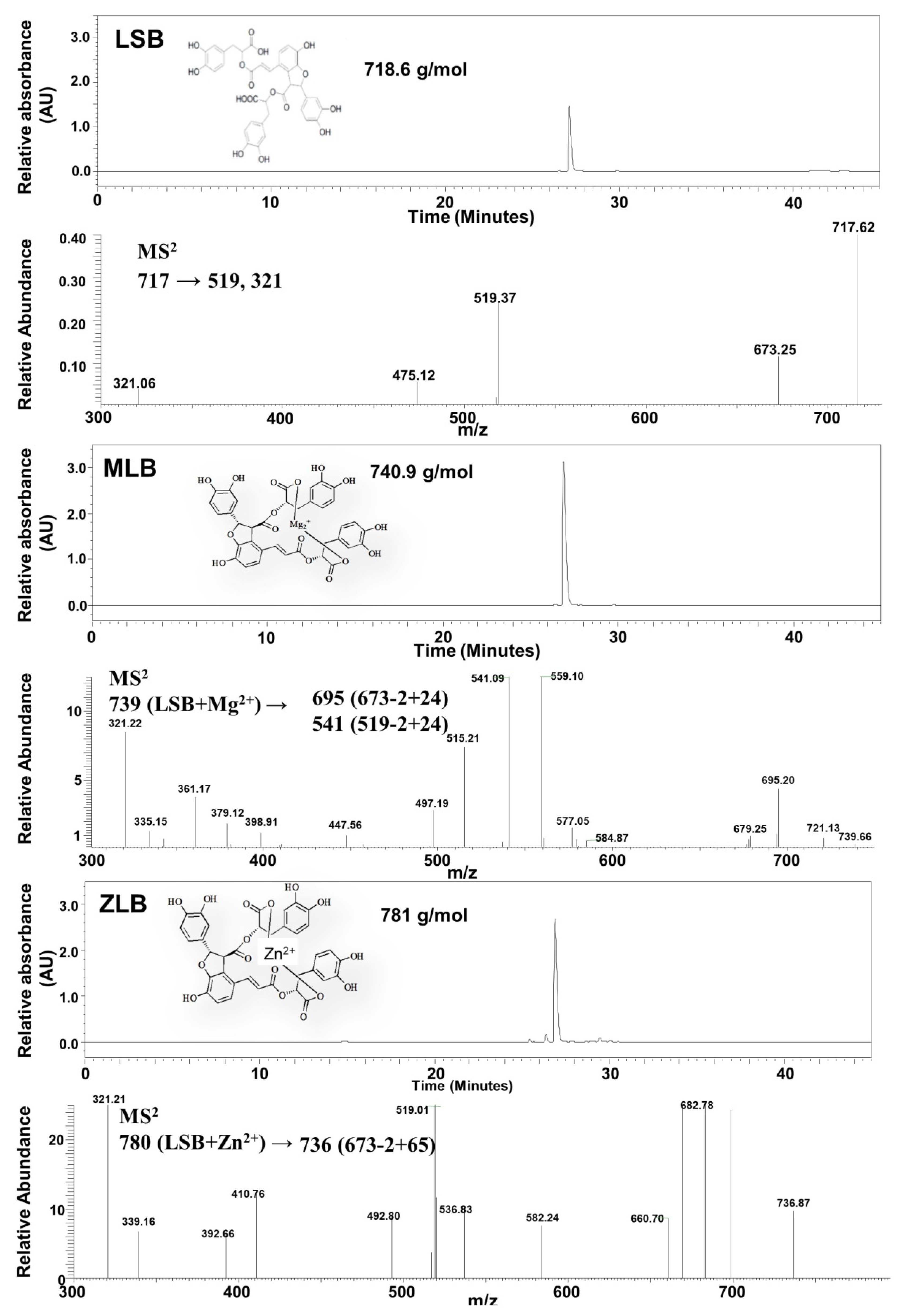
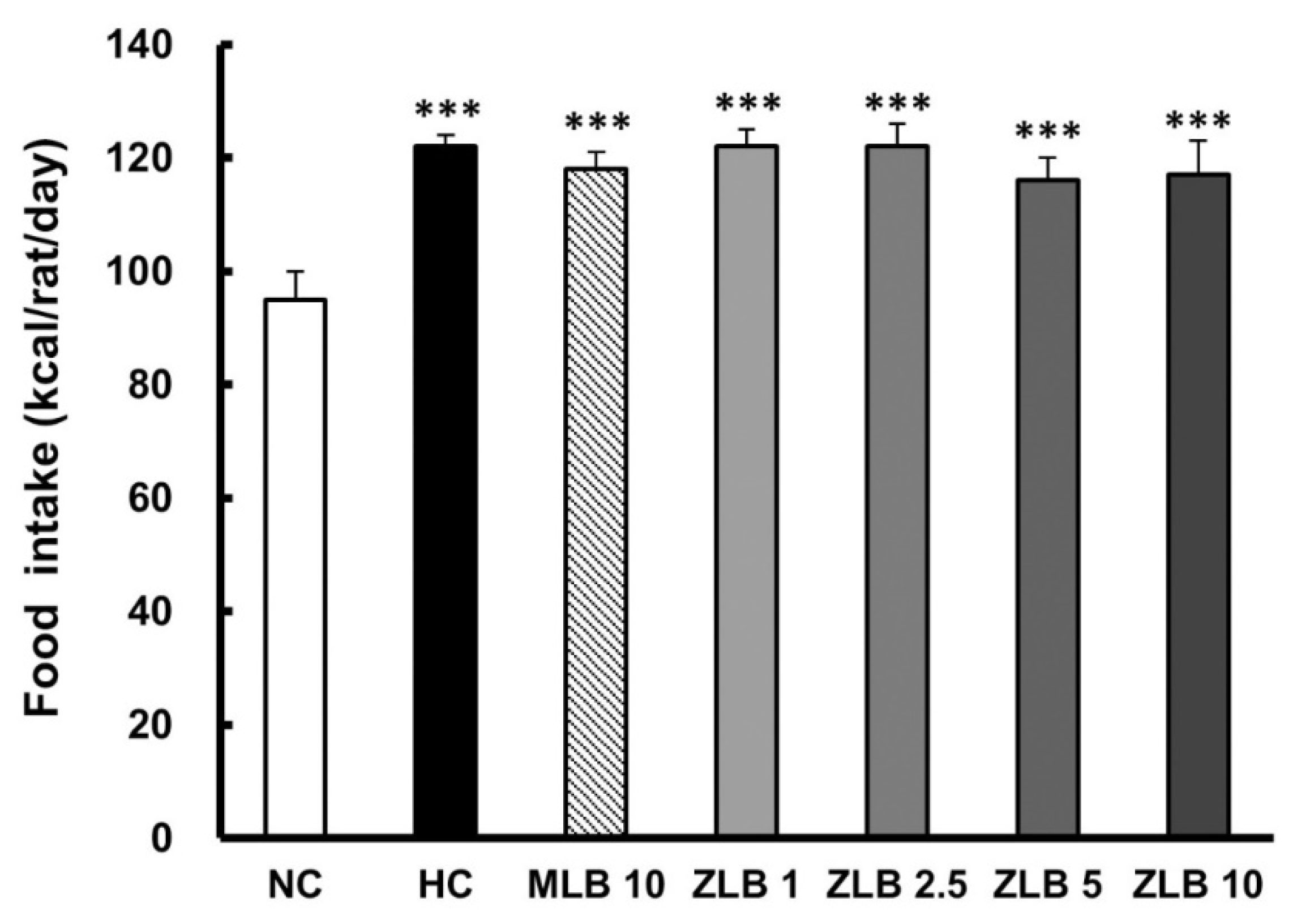
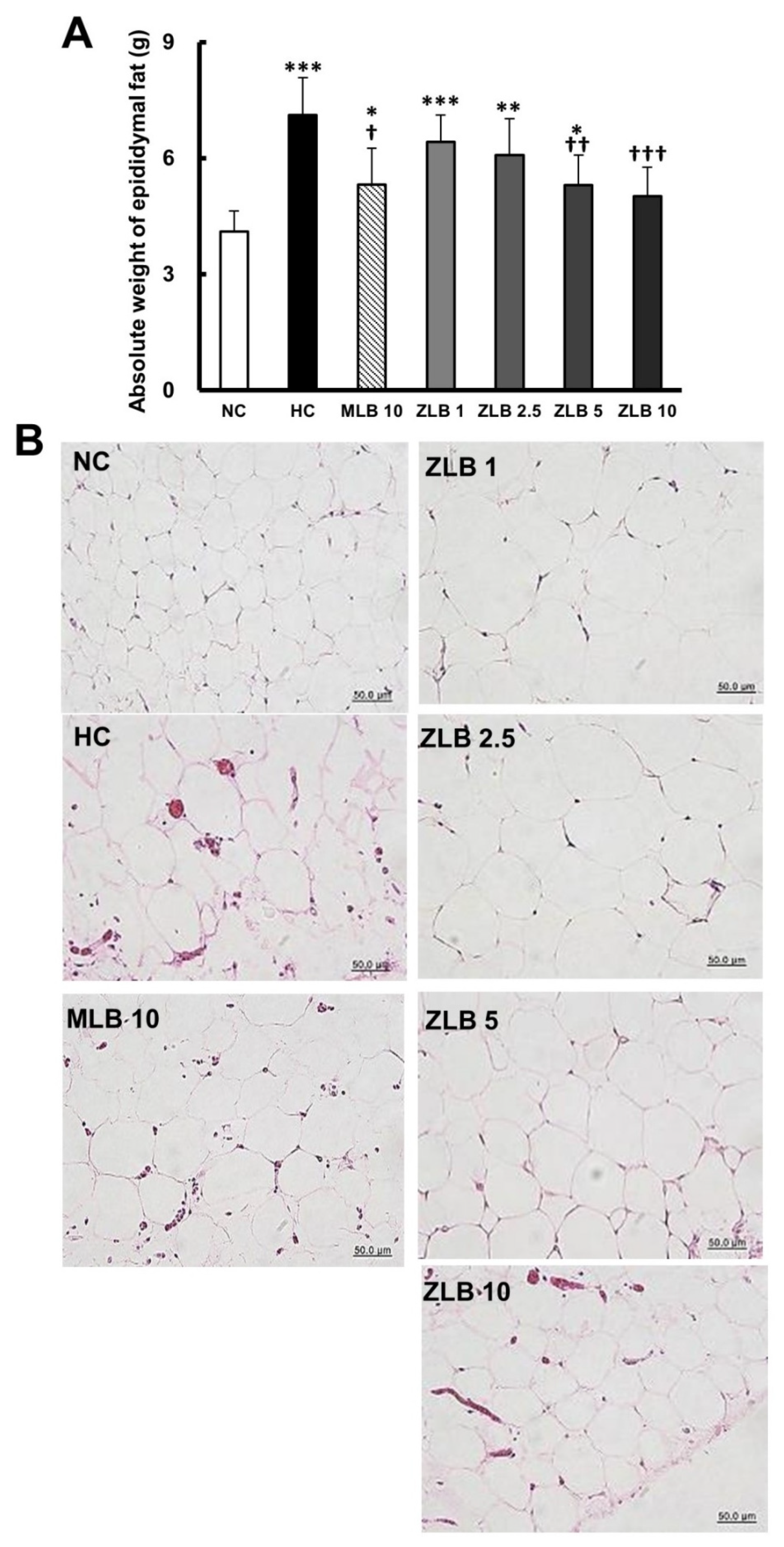


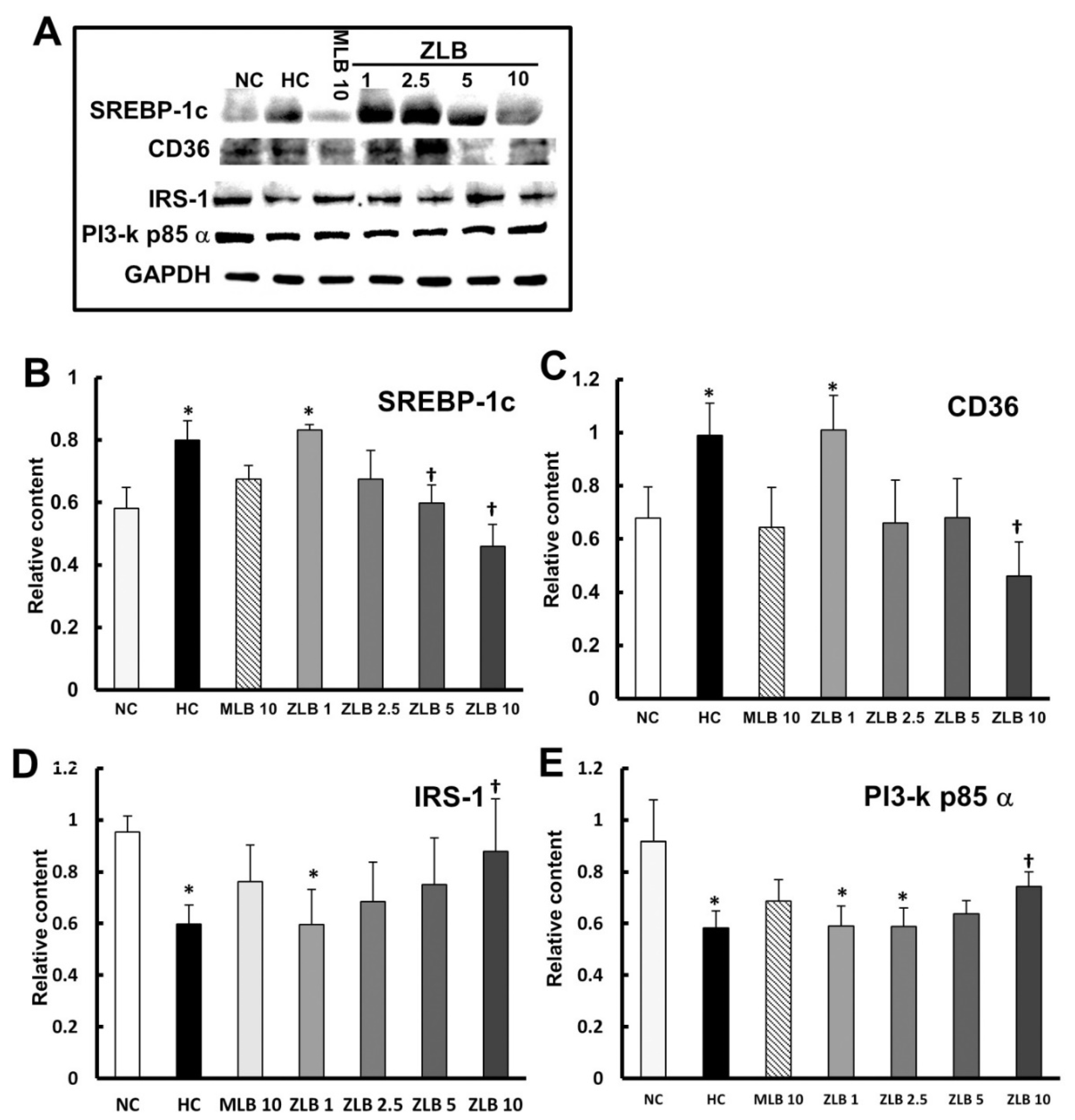
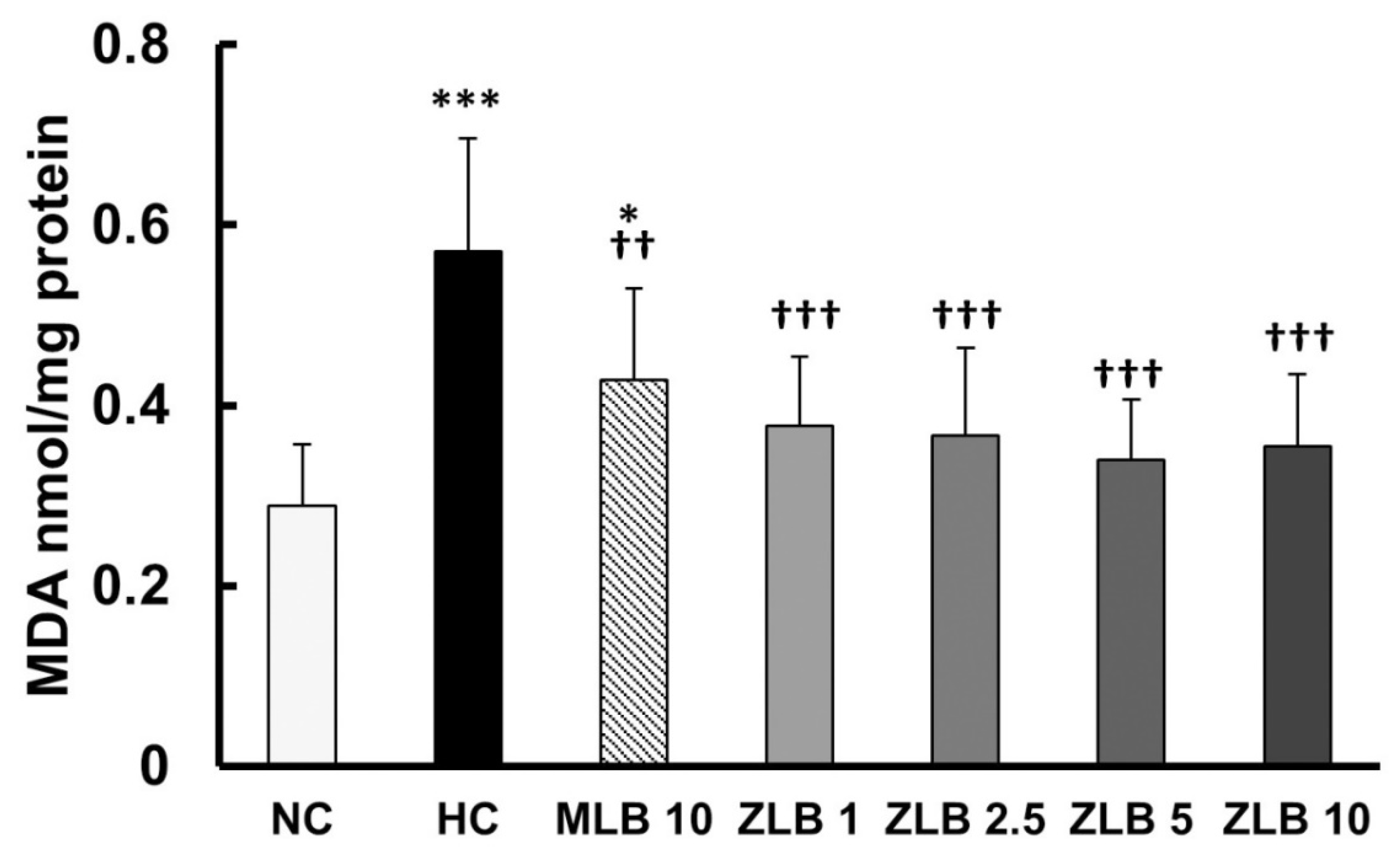

| Group | NC | HC | MLB 10 | ZLB 1 | ZLB 2.5 | ZLB 5 | ZLB 10 | |
|---|---|---|---|---|---|---|---|---|
| Day | ||||||||
| 1 | 168 ± 4 | 166 ± 8 | 162 ± 8 | 164 ± 3 | 167 ± 6 | 153 ± 5 | 161 ± 6 | |
| 5 | 216 ± 6 | 218 ± 5 | 213 ± 10 | 213 ± 6 | 223 ± 6 | 207 ± 6 † | 209 ± 3 | |
| 8 | 242± 8 | 247 ± 7 | 238 ± 10 | 240 ± 9 | 251 ± 8 | 234 ± 6 † | 233 ± 4 † | |
| 12 | 280 ± 11 | 299 ± 7 ** | 284 ± 13 † | 287 ± 11 | 296 ± 11 * | 276 ± 9 ††† | 274 ± 6 ††† | |
| 16 | 311 ± 12 | 345 ± 8 *** | 320 ± 17 ††† | 333 ± 14 ** | 335 ± 10 *** | 315 ± 8 ††† | 310 ± 5 ††† | |
| 21 | 339 ± 19 | 396 ± 15 *** | 361 ± 18 *,††† | 375 ± 16 ***,† | 379 ± 16 *** | 355 ± 8 ††† | 352 ± 5 ††† | |
| 26 | 357 ± 13 | 421 ± 18 *** | 380 ± 14 *,††† | 413 ± 22 *** | 404 ± 17 *** | 389 ± 8 **,†† | 372 ± 15 ††† | |
| 30 | 376 ± 17 | 448 ± 21 *** | 400 ± 17 *,††† | 441 ± 21 *** | 425 ± 15 ***,† | 400 ± 8 *,*** | 395 ± 14 ††† | |
| NC | HC | MLB 10 | ZLB 1 | ZLB 2.5 | ZLB 5 | ZLB 10 | |
|---|---|---|---|---|---|---|---|
| AST (U/L) | 154.3 ± 17.4 | 233.7 ± 39.9 *** | 164.0 ± 24.0 ††† | 247.3 ± 49.5 *** | 189.5 ± 23.8 † | 168.5 ± 13.7 ††† | 164.3 ± 23.1 ††† |
| ALT (U/L) | 52.2 ± 5.5 | 62.7 ± 5.8 * | 48.5 ± 7.8 † | 54.0 ± 7.0 | 52.7 ± 9.2 | 49.0 ± 5.4 † | 44.0 ± 6.9 †† |
| BUN (mg/dL) | 15.3 ± 2.1 | 11.0 ± 1.8 | 11.3 ± 1.8 | 9.8 ± 1.7 | 11.3 ± 1.0 | 11.5 ± 1.0 | 11.8 ± 1.0 |
| Creatinine (mg/dL) | 0.7 ± 0.1 | 0.7 ± 0.1 | 0.7 ± 0.1 | 0.7 ± 0.1 | 0.7 ± 0.1 | 0.6 ± 0.0 | 0.7 ± 0.1 |
| TC (mg/dL) | 47.8 ± 9.4 | 65.0 ± 9.3 ** | 54.8 ± 4.6 | 67.3 ± 7.3 *** | 58.3 ± 12.0 | 55.0 ± 11.4 | 51.0 ± 4.3 †† |
| TAG (mg/dL) | 26.5 ± 4.5 | 42.8 ± 8.0 ** | 31.2 ± 3.8 ††† | 43.5 ± 5.0 ** | 45.2 ± 5.7 ** | 33.3 ± 3.4 | 33.7 ± 7.1 |
| non-HDL-C (mg/dL) | 18.2 ± 7.4 | 28.2 ± 5.1 ** | 19.7 ± 8.5 † | 20.3 ± 2.3 † | 17.5 ± 5.1 †† | 18.5 ± 3.0 †† | 18.2 ± 4.3 †† |
| HDL (mg/dL) | 28.2 ± 6.7 | 16.5 ± 5.9 ** | 28.3 ± 4.5 †† | 24.7 ± 7.5 † | 26.2 ± 5.7 † | 28.5 ± 9.5 †† | 25.2 ± 7.3 † |
| TNFα (pg/dL) | 0.72 ± 0.25 | 10.66 ± 2.66 *** | 3.36 ± 1.77 †† | 7.21 ± 1.69** | 6.66 ± 1.44 ** | 5.30 ± 1.3 *, † | 5.22 ± 0.94 *, † |
| Leptin (pg/dL) | 94.65 ± 4.71 | 252.57 ± 45.46 *** | 148.08 ± 46.89 †† | 199.10 ± 20.25 * | 204.89 ± 38.60 * | 151.88 ± 13.57 † | 155.66 ± 15.36 † |
| Group | NC | HC | MLB 10 | ZLB 1 | ZLB 2.5 | ZLB 5 | ZLB 10 | |
|---|---|---|---|---|---|---|---|---|
| Time (min) | ||||||||
| 0 | 97 ± 2 | 115 ± 9 *** | 104 ± 4 | 112 ± 5 *** | 112 ± 6 *** | 103 ± 5 †† | 104 ± 3 †† | |
| 30 | 473 ± 55 | 578 ± 30 *** | 510 ± 16 †† | 579 ± 31 *** | 524 ± 45 *,† | 506 ± 32 †† | 509 ± 38 †† | |
| 60 | 295 ± 31 | 445 ± 70 *** | 335 ± 38 †† | 439 ± 44 *** | 387 ± 90 * | 367 ± 41 † | 357 ± 41 † | |
| 90 | 155 ± 10 | 252 ± 18 *** | 203 ± 24 **,† | 273 ± 23 *** | 210 ± 47 **,† | 207 ± 34 **,† | 206 ± 26 **,† | |
| 120 | 126 ± 9 | 179 ± 9 *** | 153 ± 21 *,† | 176 ± 13 *** | 177 ± 30 *** | 156 ± 20 * | 154 ± 13 *,† | |
© 2020 by the authors. Licensee MDPI, Basel, Switzerland. This article is an open access article distributed under the terms and conditions of the Creative Commons Attribution (CC BY) license (http://creativecommons.org/licenses/by/4.0/).
Share and Cite
Hsieh, S.-K.; Lin, N.-H.; Chen, Y.-J.; Lee, M.-R.; Chen, W.-Y.; Tzen, J.T.C. Therapeutic Effects of Lithospermate B Complexed with Mg2+ or Zn2+ on Metabolic Syndrome Induced in Rats Fed with High-Fat Diet. Molecules 2020, 25, 983. https://doi.org/10.3390/molecules25040983
Hsieh S-K, Lin N-H, Chen Y-J, Lee M-R, Chen W-Y, Tzen JTC. Therapeutic Effects of Lithospermate B Complexed with Mg2+ or Zn2+ on Metabolic Syndrome Induced in Rats Fed with High-Fat Diet. Molecules. 2020; 25(4):983. https://doi.org/10.3390/molecules25040983
Chicago/Turabian StyleHsieh, Sheng-Kuo, Nan-Hei Lin, Ying-Jie Chen, Maw-Rong Lee, Wen-Ying Chen, and Jason T.C. Tzen. 2020. "Therapeutic Effects of Lithospermate B Complexed with Mg2+ or Zn2+ on Metabolic Syndrome Induced in Rats Fed with High-Fat Diet" Molecules 25, no. 4: 983. https://doi.org/10.3390/molecules25040983







